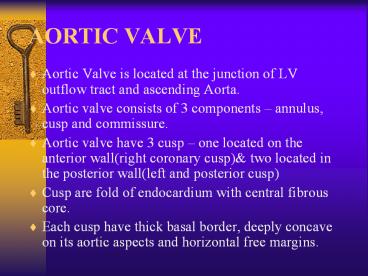AORTIC VALVE - PowerPoint PPT Presentation
1 / 21
Title:
AORTIC VALVE
Description:
AORTIC VALVE Aortic Valve is located at the junction of LV outflow tract and ascending Aorta. Aortic valve consists of 3 components annulus, cusp and commissure. – PowerPoint PPT presentation
Number of Views:735
Avg rating:3.0/5.0
Title: AORTIC VALVE
1
AORTIC VALVE
- Aortic Valve is located at the junction of LV
outflow tract and ascending Aorta. - Aortic valve consists of 3 components annulus,
cusp and commissure. - Aortic valve have 3 cusp one located on the
anterior wall(right coronary cusp) two located
in the posterior wall(left and posterior cusp) - Cusp are fold of endocardium with central fibrous
core. - Each cusp have thick basal border, deeply concave
on its aortic aspects and horizontal free margins.
2
Continue...
- Behind each cusp aortic wall bulges to form
aortic sinus of valsava. - Coronary arteries arise form the sinus(right
coronary artery anterior cusp, left coronary
artery left posterior cusp) - Aortic valve consisted of annulus but there is no
complete collagenous ring supporting the
attachment of leaflet - Commusures form tall peacked space between the
attachment of adjacent cusp and attain the level
of aortic sinotubular junction - Aortic cusp form central closure line in
diastole, in systole the cusp open and close
again at the end systole when aortic pressure
exceeds the LV pressure
3
(No Transcript)
4
- Normal valve area (cm2) _ 2.5 3.5cm2
- Normal velocity of aorta (m/s) 1 1.7 m/s
5
AORTIC STENOSIS
- Narrowing of aortic orifice
- Aortic stenosis develops slowly except in
congenital form - Aortic stenosis occurs in three levels
- Valvular Aortic Stenosis(Causes)
- Rheumatic Heart Disease
- Calcific Aortic Stenosis associated with
increasing age - Congenital Bicuspid Valve(A bicuspid valve
is found in 40 of middle aged individual
with aortic stenosis and 80 of elderly
individual with aortic stenosis - Bicuspid Aortic valve is congenital
abnormality affecting 1-2 of population and
result in cusp which separate normally but
usually have eccentric closure line which may
lie interiorly or posteriorly.
6
Continue...
- Sub Valvular Aortic Stenosis(caused by
obstruction proximal to AV) - Sub aortic membrane
- Hypertrophic cardiomyopathy
- Tunnel Sub aortic obstruction
- Upper septal bulge this is due to fibrosis
and hypertrophy usually seen in elderly
individual - Supra Valvular Aortic Stenosis
- This occur in some congenital condition such as
Williams syndrome (which includes hypercalcemia,
growth failure and mental retardation)
7
(No Transcript)
8
(No Transcript)
9
- Normal valve area
- Normal 2.5 - 3.5
- Mild 1.5 - 2.5
- Moderate 0.75-1.5
- Severe lt0.75
- Peak Velocity (m/s)
- Normal 1.0
- Mild 1.0 2.0
- Moderate 2.0-4.0
- Severe gt4.0
- Peak gradient(mmHg)
- Normal lt10
- Mild lt20
- Moderate 20-64
- Severe gt64
10
Valvular Aortic stenosis
Valvular Aortic stenosis.
11
(No Transcript)
12
Clinical Features
- Symptoms
- Mild to Moderate AS is usually asymptomatic
- Exertional Dyspnea
- Angina
- Exertional Syncope
- Sudden Death
- Episode of acute Pulmonary Edema
- Signs
- Ejection systolic murmer
- Slow rising carotid pulse
- Narrow pulse pressure
- Thirsting apex beat(LV pressure overload)
- Signs of pulmonary venous congestion
13
Investigation
- ECG LVH, LBBB
- X-ray - LV enlargment
- Echocardiogram
- 2D Echo
- Cusp may seen thickened, calcific reduced
motion or may dome - There may be LVH due to pressure overload
- LV dilatation occur if heart failure has
developed - Post stenotic dilatation of aorta may be
seen - Doppler Turbulant flow.
- Can asses the
severity of AS by estimating the pressure
gradient across the AV.
14
Management
- Patient with symptomatic AS and valve gradient
indicative of moderate or severe stenosis(gt50 mm
Hg)should have valve replacement - Aortic Balloon Valvuloplasty is useful in
congenital aortic stenosis - Anticoagulants are required only if patient have
atrial fibrillation or have valve replacement
with mechanical prosthesis
15
Aortic Regurgitation
- This is leakage of blood from aorta to LV during
diastole - Causes
- Congenital
- Bicuspid valve or disproportionate cusp
- Accquired
- Rheumatic Disease
- Infective Endocarditis
- Trauma
- Aortic Dilatation(Marfan syndrome, anneurysm,
dissection, syphyllis)
16
(No Transcript)
17
Clinical Features
- Symptoms
- Mild moderate AR often asymptomatic
- Awareness of heart beat pulsation
- Severe AR Breathlessness, Angina
- Signs
- Pulse
- Large volume or collapsing pulse
- Bounding peripheral pulse
- Capillary pulsation in nail bed _Quinekes Sign
- Femoral bruit
- Head nodding with pulse
- Murmur
- early diastolic murmur
- systolic murmur
- Austin flint murmur (soft mid diastolic)
- Other Signs
- Displaced rocking apex beat
- Fourth heart beat sound
- Pulmonary Venous Conjestion
18
INVESTIGATION
- ECG LVH
- X-ray Cardiac Dilatation, features of LVH
- Echocardiogram
- M mode and 2D Echo LV dilatation with severe
AR, progressive dilatation with symptoms or left
ventricular end systolic diametre in excess of
5.5cm - Pulse Vave Doppler
- Can give idea of severity by seeing how far into
the LV cavity the AR jet reaches - Mild AR remains within the area of AV
- Moderate AR remains between the LVOT level of
mitral valve above papillary muscle level - Severe AR extend to LV apex
- Continuous Wave Doppler
- The slope of deccelaration rate of the doppler
signal of AR can give an indication of severity
19
Doppler
- High velocity turbulent flow in diastole because
of aliasing direction of flow is not seen
correctly but dominant doppler signal are above
the base line.
20
Management
- Treatment for endocarditis
- AVR indicated if AR causes symptoms
- Vasodilators have been shown to prevent left
ventricular dilatation - When aortic root dilatation is cause of AR aortic
root replacement may be necessary
21
(No Transcript)































